What it takes to make a living playing poker tournaments – Poker Fortress
Not many can play tournaments for a living. There are certain traits required you need to master to be able to. To play tournaments professionally, it takes the following:
Love for the game
Able to focus and be disciplined
Proven track record of your winnings
Have the required skills to beat the game
Treat tournaments as seriously as you would the real job
Enough time to play
Money for your bankroll to register for tournaments
Work on your game off the tables
To make a living playing poker tournaments, you first and foremost must have the love for the game. Playing tournaments can be very stressful and painful at times, so you have to have that fire burning to handle all the heat that that tournament poker will throw at you. That doesn’t mean that you will never get annoyed or angry playing poker. It takes a lot of mental focus and discipline for making tough decisions in-game and in preparation for the game.
 You need to master a few things before becoming a pro tournament poker player.
You need to master a few things before becoming a pro tournament poker player.
To become a poker professional, you have to have some track record that proves that you are a profitable player. You can’t just wake up one day and decide to become a poker pro. You must have the necessary skills to beat the game. One big tournament win isn’t enough of evidence that you are a winning player. Nobody is born a poker “crusher,” but a lot of people have the potential to become one.
Poker tournaments are very competitive by nature. Tournament structure forces players into constant confrontations. In poker as in any game, you have to beat your opponents to win, and so you must have some level of competitiveness in you to excel in it.
As a poker professional, you have to realize that poker will take a lot of your time. You have to treat poker as seriously as you would any other profession. Even though poker can provide a comfortable life, you still have to work hard to achieve positive results.
Besides time you are going to need the money that can be put into your poker bankroll.
You can’t play poker professionally without sufficient bankroll and skills to manage it.
Can you make a living playing poker tournaments?
If you have all that it takes, you can make a pretty decent living playing poker tournaments. But everybody has a different definition of “decent living.” Making a 1k per month sounds promising if you live in eastern Europe or Asia and not so promising if you are from Sweden or Canada.
It can be effortless to grind micro and low stakes for a “minimum wage,” but to earn more lucrative money, you will have to go the extra mile and put in some hard work of the tables. Tournament poker gets tougher every year even in low stakes, so you have to keep your game sharp to stay in front of the competition.
In a table below, you can see how much solid tournament regulars make per month. With the help of a tournament variance calculator, we calculated expected profits for different stake levels. At lower stakes, the achievable ROI (return on investment) is much higher because the competition is weaker than in mid-stakes.
Higher ROI means less overall variance, which leads to lower bankroll requirements and lower probability of having a losing month. You have to realize that EV (Expected value) is just a theoretical number, and there are no guarantees that you will actually earn that amount. There is a lot of uncertainty in tournament poker, and that is why bankroll requirements are so high.
It is improbable that a 40% ROI player will go on a 300 BI (Buy-in) downswing, but psychologically it is good to know that you can go and still be safe.
Micro stakes regLow stakes regMid stakes regAverage buy-in5$12$30$ROI40%30%20%Expected value ($)1,60025203600Avg field size (players per mtt)600500400Tournament count (per month)800700600Required bankroll ($)2k (400BI)6k (500BI)18k (600BI)Probability of having a losing month5%11%20%Expected profits depending on your ROI. As a mid stakes player you will play less tournaments per month as less of them run compared to micros.
As you see, you can make some serious money when you can beat the mid-stakes.
In Slovenia, the prime minister gets paid 3300€ after taxes per month, which is just about the same amount that solid mid-stakes regular makes. That is somewhat crazy if you think about it. In one job, you are pressing mouse buttons on the internet, while in other, you continuously have to make real-life decisions that concern the whole nation.
Types of tournaments
Poker rooms spread many variants and game types of poker tournaments. From more obscure games like PL (Pot-limit) 5 card Omaha to classic NL (No-limit) freezeouts. It is tough to play professionally any other variant than NL Holdem. There are just not enough tournaments to put in any serious volume. Maybe you can find enough Omaha tournaments to fill up the schedule, but you will have to look for mtts (multi-table tournaments) on many sites.
Types of poker tournaments:
Progressive knockouts (PKO)Regular tournamentsTurbo tournamentsHyper-turbo tournamentsDeep stack tournamentsSatelites
The vast majority of players have NL Holdem tournaments as their main game. But even NL Holdem by itself has many types that demand a specialized skill set. Progressive knockouts (PKO) demand a different approach to regular tournaments. Turbos and hypers demand more preflop push or fold sharpness while deep stack tournaments require more post-flop fines.
Bankroll management
One of the most crucial skill to have in poker is proper bankroll management. You would think that the lack of skill is the main reason that most poker players go bankrupt, but actually, it is the improper bankroll management. Some players get bored playing their usual stakes and take shots at higher stakes even though it might be fiscally irresponsible.
You can be the most skilled poker player in the world, but if you don’t practice proper bankroll management, you will eventually go bust.
By proper bankroll management, I mean correctly investing assets in your poker bank to minimize the risk of ruin and maximize the profits. You should not play the 100$ tournament with 1000$ bankroll even if you feel that it is your lucky day.
In the short term, you are going to face more variance in mtts then in CG. It is not unusual to go on 100+ BI downswings or to break even over a thousand mtts. If you are not practicing proper bankroll management, you are putting yourself in constant danger of going bust.
Pro or a hobby tourney playerBankroll requiredProfessional playerminimum 250, up to 1000 buyinsHobby tourney player100 buyinsProfessional poker player needs to have a much bigger bankroll to play tournaments for a living.
If you want to play a tournament at a particular level, you should have at least 100 buy-ins in your poker bank. But that is just a bare minimum, and I would never recommend playing professionally with only 100 BI. If you are a poker enthusiast who recreationally plays poker, 100BI should be enough to get you started, but to play professionally, you should have somewhere between 250 and 1000 buy-ins.
The number of BI per stake level greatly depends on how much you are beating the games for (how good you are). Just having the money doesn’t automatically means that you are qualified to play higher stakes. Good regular with a solid track record can get away with a lot looser bankroll management than some mediocre player who barely beats the games.
You have to ask yourself if you are in a faze when you are building or maintaining a bankroll. It depends a lot on your general poker goals. Are you just fine grinding at a certain level, or are you planning to move up? Some poker professionals don’t separate life and poker roll. I would suggest that you do, especially if you are just starting because separation can provide a lot more clarity about your financial status.
Separate poker bankroll and your life roll.
Life roll
If you want to start playing poker professionally, you should have some money saved for living expenses. To be on the safer side, you should have the funds for at least six months of living. Playing poker, especially MTTs, can be very stressful, so you should try to eliminate all other stressors. Thinking about if you are going to make it or not till next month can take away a lot of unnecessary focus from poker. A little uncertainty can motivate you to push harder, but constant stress will wear you down eventually.
When you start making money playing poker, you should decide when to transfer funds from poker bankroll to life roll. There are many ways to do it. You should have some structure to it and not just randomly withdraw whenever you need money.
You can withdraw the desired sum once per month or more gradually during the month. I make a small withdraw every time I have a winning session, so I consequently don’t even notice that any money is missing from my bankroll. Find a way that you feel comfortable with and keep your life roll healthy.
Proper scheduling
If you are taking your job as a poker player seriously, you should create a playing schedule. By that, I don’t mean just the time frame but also the list of tournaments that you plan to play in that period.
When you are creating your monthly plan, you have to decide on a number of tournaments that you intend to play. If you want to reach a goal of, let’s say one thousand tournaments, you have to play 33 mtts per day. And since it would be best if you take a couple of days off, you have to play around 40 per playing day if you want to reach your monthly goal.
Now that we know how many mtts do we need to play per day we have to select a time period where we can play that amount most time efficiently. That time frame greatly depends on how many tables are capable of comfortably playing. You are going to reach your daily goal much faster if you play 12 instead of 6 tables.
You want to start your session at a time where you can register a lot of desired tournaments at once.
Ideally, if you are twelve tabling, you would want to start when you can open 12 mtts at the same time. You can warm up your session by playing fewer tables but mind that your hourly rate goes down when you play less than the optimal number of tables. The creation of the most time-efficient schedule takes a lot of trial and error.
You are quickly going to recognize which tournaments are not worth playing because you are continually going to end up one tabling them. It can be very annoying to one table for 3 hours a low stake tournament where you are making 0.50c per hour. The most straightforward advice would be to skip slow and deep structured mtts that start at the end of your registering time period.
To create an optimal playing schedule, you need to research the tournament offers on all the poker sites available to you. You shouldn’t just play on one poker site because you will miss out on a lot of potential value.
It can be valuable to have an account on smaller sites even just to play a couple of tourneys here and there. You can potentially have much higher ROI in some Sunday majors on Ipoker than on Pokerstars.
Some players register all the desired tournaments at the beginning of their sessions others wait till the start of the tournaments. I personally like to register them a couple of minutes after the start because you usually get less reg infested tables (table filed with professionals). I have an alarm clock application where I input all the tournaments, and when the mtt starts, I get a notification.
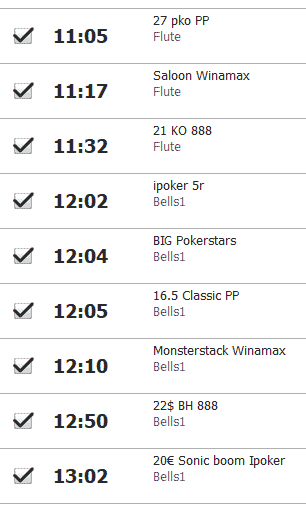 An example of alarm clock reminders for when the certain tournament is starting.
An example of alarm clock reminders for when the certain tournament is starting.
Volume
Playing a sufficient amount of tournaments is crucial for long term success as a pro player. Tournament professionals play somewhere between 400 and 1000 mtts per month. That number depends on multiple factors:
How many tables is a player able to play profitablyHow high are the stakes (High stakes tournaments demand more focus)What type of tournaments a player prefers (small field turbos on average take way less time than some slow and deep stacked Sunday mayor)
It is necessary to put in a sufficient volume of mtts. Otherwise, it can take way too much time for you to realize your EV. Tournament grind can be very grueling, and it is very common for players to go on losing or breakeven stretches that can last for months. This is especially true if you are mainly playing large-field tournaments. Odds of winning a major tournament are stacked against you from the get-go.
It is very important to have a diversified list of tournaments that consist of a lot of small field tournaments and some major ones that can bring you that big score that every player is dreaming of.
Multi-tabling
A necessary skill of tourney pro is the ability to multi-table. Everybody can open ten tables, but to play them effectively is a skill that is learned over time. You have to be so comfortable with your game that you can make quick decisions. You have to accept that you will play less than optimal when mass multi-tabling. You won’t be able to follow all the action on your tables, which can reveal some crucial information about your opponents.
Your ROI per mtt will drop with the number of tables, but your hourly rate will increase with a higher volume.
The standard strategy to increase the number of tables is to add them slowly with time. You have to be comfortable with six tables before you start thinking about adding more.
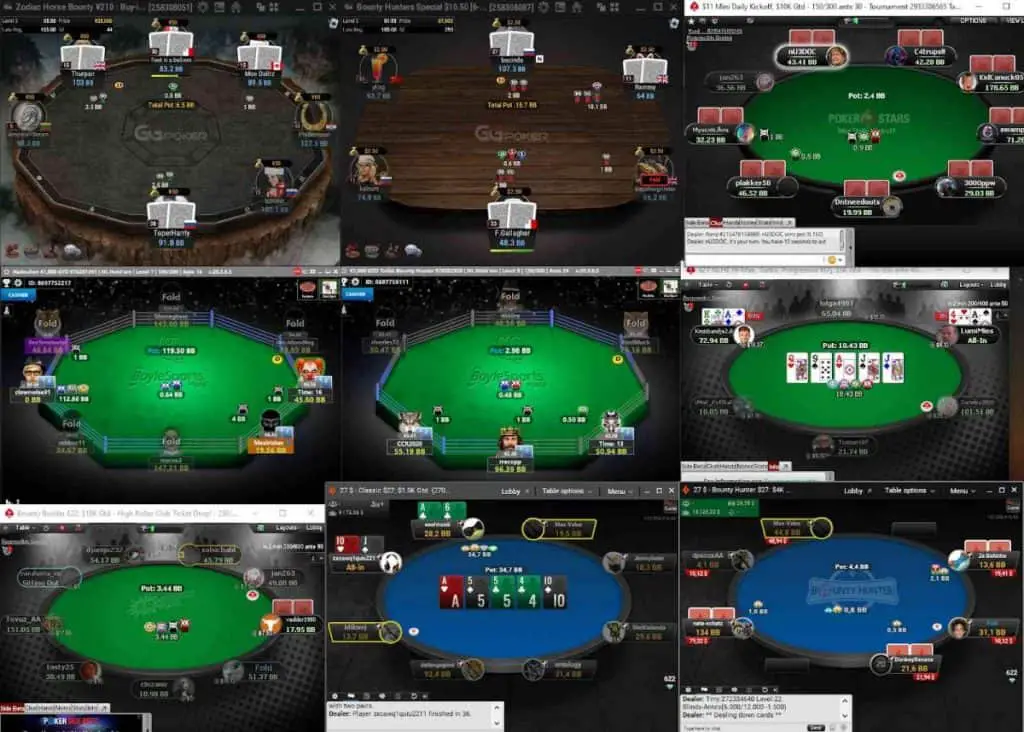 Multitabling is a great way to increase your hourly income. But make sure you can handle more tables first.
Multitabling is a great way to increase your hourly income. But make sure you can handle more tables first.
Tournament selection
The selection of tournaments is very player dependent. Only you know which types of tournaments suits you the most and where you have the strongest track record. These days poker sites offer many variations of NL Holdem tournaments, from 6max Turbo PKOs to regular full ring deep stacks.
Your ROI will vary depending on the tournament type. In slow structured tournaments, achievable ROI is much higher than in turbos (Find out why in this article). You might crush regular 22$ tournaments with 50% ROI and barley brake even in 22$ 6max PKO because you don’t make proper adjustments.
Mind also that 6max tournaments take more focus then full ring, so if you intend to mass multi-table, try to avoid playing too many of them. 6max game in general plays more aggressively, and even the recreational players that they play them are more tricky. To outplay them, you will have to pick up some reads, which will be hard if you are 12 tabling.
The field size of the tournaments massively influences the variance that you are going to suffer. Small field tournaments offer a more steady income, while in large fields, it might take a huge volume for you to realize your EV. And since variance is big as it is in MTTs, you want to mitigate it somehow.
Including a lot of small field tournaments in your playing schedule is a great way to mitigate the variance.
For example, if you have 10k in your bankroll, you should play an average buy-in (ABI) of around 20$. ABI is the sum of all your buy-ins divided by the number of tournaments played.
ABI = (SUM of BI) / count of mtts
ABI = (55$ + 33$ + (3×11$) + 22$ + 5$) / 7 = 21.14 $
As you see you can still be very flexible when it comes to the size of a BI and still follow the guidelines of healthy bankroll management
How to find the softest tournaments
You should include the softest tournaments that you can find for your BI range. You can just play a tournament a couple of times and observe how tough the field is. But there is another option that gives you a more analytical assessment of tongues of the field.
With the application Sharkscope, we can search for the tournament in interest, and as a result, we will get a stat: the average ability of the tournament (Check the picture below). The lover that number the softer is the tournament. Each tournament has its ID that can be found in the tourney lobby. When you type that number in the Sharkscope search engine, you get a tournament report that provides av. ability.
If you don’t know if Sharkscope is right for you, then I have a detailed review and an expert guide for you on this link.
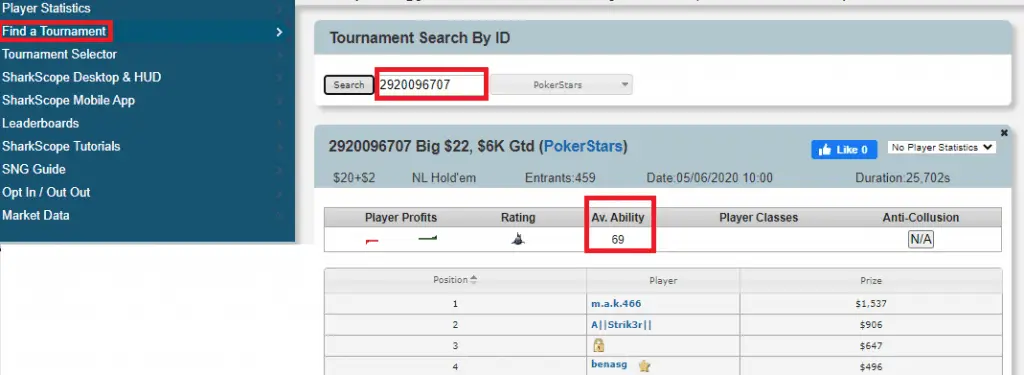 With Sharkscope you can easily find the softest poker tournaments.
With Sharkscope you can easily find the softest poker tournaments.
Analytic software
If you are taking your games seriously, you have to invest in the additional poker software. Analytical poker tools are getting cheaper and user-friendlier every year. Manual hand analysis that used to needed expert knowledge is now automated to a point where you can just paste HH into a tool and press calculate.
It goes without saying that HH (hand history) tracking program is a must and they are widespread among the poker pros. It tracks your results and provides HUD (Heads-up display) when you are playing. HUD provides excellent support, especially when you are mass multi-tabling. Without it, you are unable to follow all the action at the tables.
For gathering additional information about your opponents, you have to have access to a global database with tournament results. Checking your opponents’ results should give you some new reads. Sometimes it is enough to know whether somebody is a regular or recreational player when deciding on a hero call or fold. If you want to have a sharp push fold strategy (which is necessary), you always need to analyze HH with tools like ICMizer. These sorts of programs offer you preflop solutions to situations that continuously occur in tournament poker.
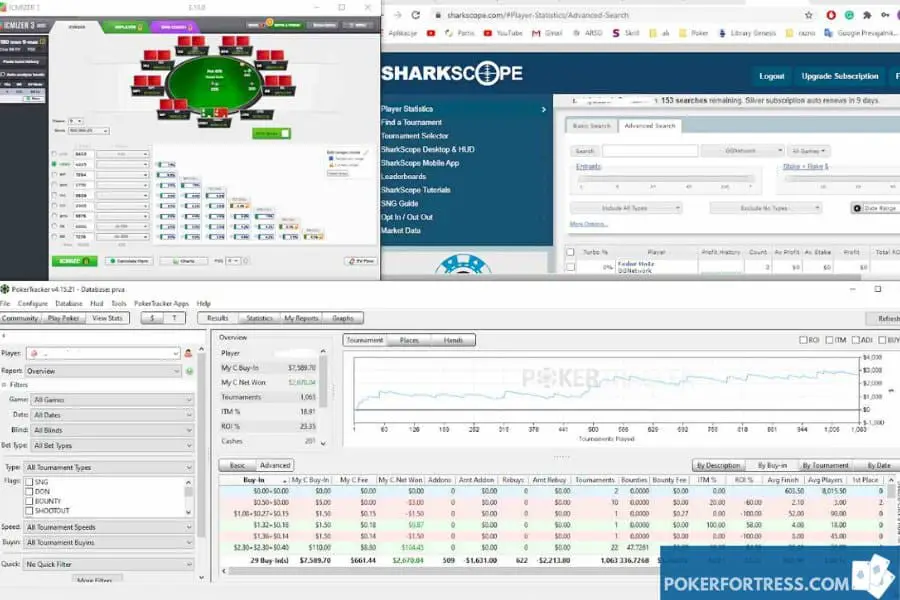 Every tournament poker professional will use this kind of programs on a daily basis.
Every tournament poker professional will use this kind of programs on a daily basis.
Constant improvement
As a poker professional, you have to work on your game continually. The competition is getting better/stronger every year, so you have to keep your game sharp to retain an edge on your opponents. The skills that were enough in 2015 may not be enough in 2020 and beyond, so it is necessary not to stay stagnant.
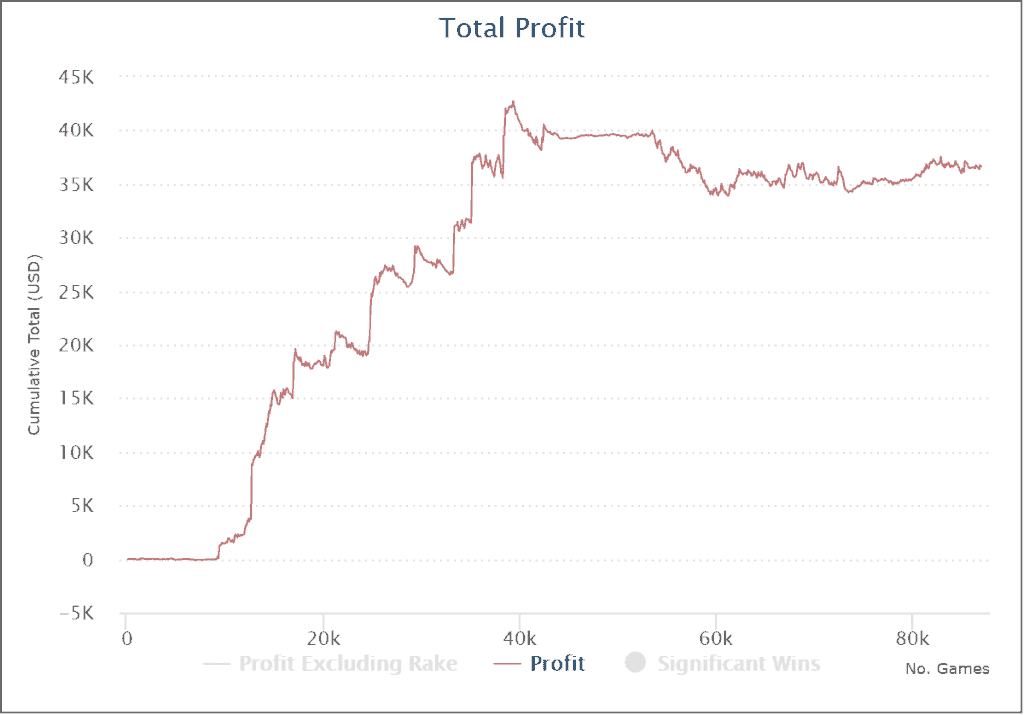 Work on your game. Otherwise it might happen that you fall behind and won’t beat the games anymore.
Work on your game. Otherwise it might happen that you fall behind and won’t beat the games anymore.
A lot of instructional poker content is easily digestible and available for free (like this article and more than 100 other blog posts on the PokerFortress website), especially for beating the low stakes. Poker content is available in all forms (videos, blogs, ebooks) and is present on all major streaming platforms (Twitch, Youtube).
Besides analyzing HH with previously mentioned tools, there are many ways to improve your game. You can join one of many training sites where you can access instructional videos made by high-level professionals (my favorite nowadays are RunItOnce and UpswingPoker).
These days you can purchase a lot of different online tournament masterclasses where you receive step by step instructions on how to improve your game. They can be a little bit more expensive, but you will receive more in-depth knowledge (the best at the time of this writing is one from RaiseYourEdge done by Bencb789, a highstakes crusher, who is considered one of the top online MTT players in the poker community).
A great way to improve is to join a study group and exchange opinions about hands with other poker players. One of the most effective ways to get better is to hire an experienced poker coach who will quickly find your leaks and provide guidance on how to fix them. But you need to be careful you find a coach that is actually worth your hard-earned money.
I have a full guide on how to find a perfect coach for you (for all price levels), so you are sure you get a good coach that will be able to transform you into a crusher.
Staking
You would be surprised how little tournament professionals play with their own money. Most of them are under some sort of staking deal. That means that they are playing for staking stable and have to share their profit with the owners.
There are two most common staking agreements that are popular:
contract-based staking for a certain period of time or tournaments played
stake for a single tournament
Usually, players have to give away somewhere between 40% and 60% of their winnings. When a player is losing, his loses go into makeup. If a player is -5k in makeup and wins an mtt for 10k, he will only split the money that is left after makeup has been settled.
Stables don’t take just winning players but also slightly losing or breakeven ones and try to transform them into winners.
Usually, the contract is signed between a player and owners of the stable for a determined time. The most common reason why players join stables is that they provide coaching and community where they can interact and exchange information with other peers.
Another way of staking is where players sell pieces of a specific tournament. Typically, that price comes with a markup. Mark up is a premium that is charged by the player. If somebody is selling pieces for a 100$ tournament with a 1.2 markup, you will have to pay 12$ for 10% of the stake.
This method is trendy in live tournament staking. Usually, online players seek investors to play higher than usual stakes in the live arena. If somebody is beating mid stakes online, he should with some adjustments, crush in some random 1k live tournament. But bankroll requirements for 1000$ live tournaments are much higher than for the 40$ average BI grind online, so it is fiscally responsible for selling some of the action.
Live tournaments
Although most tournament professionals play online, some specialize in live MTTs. The live arena offers a more romanticized aspect of poker where you can look at your opponents and pick some live reads that help you sway your decisions.
Live tournaments offer great value to pros since most of the participants play poker only recreationally. There is a somewhat unwritten rule in poker that if you can comfortably beat low stakes online, you should have no problem winning at mid-stakes live.
That of course, if you are capable of holding it together at a live table and not give away to many tells. It can feel more comfortable to pull a big bluff online where you just press a couple of buttons then live where every table is staring at you and judging your every move.
Achievable ROI in live tournaments is usually much higher than online. Good regulars have somewhere around 5% ROI in 1k online mtt while they can expect to have from 50 to100% ROI in live 1k. The fields are just that much softer. But you have to take into consideration that live mtts take on average way longer, and you can play only one at a time.
When calculating the profitability of live tournaments, you have to take into consideration traveling expenses. They can eat up a lot of your ROI if you are not planning your trips carefully. Traveling into another country and staying there for a weekend to play a tournament can cost more than you are expected to win.
Organize your travel around big live series (Where you can play a lot of mtts in a short period) or move close to a casino and be near the action all the time.
Conclusion
Like in any other business, if you have the necessary knowledge and skills, you have a good chance of succeeding as a poker player. You have to expect that it is going to be a very bumpy ride. There are minimal guarantees in the poker business. Luck plays a significant role in the short term success, so you have to expect that some days (or weeks, months) things just won’t go your way even if you do nothing wrong.
If you have a regular job and are thinking of becoming a tourney pro, you have to realize that there are no fixed salaries in poker. But there are some positives in having a job with no fixed salary. In a regular job, it’s almost impossible to earn more than your fixed monthly salary, but in poker, your earnings can be scaled up. That means that you have an opportunity of having a massive payday. In tournament poker, you have an opportunity to win life-changing money with one big tourney score.
Related Articles
Free trial



